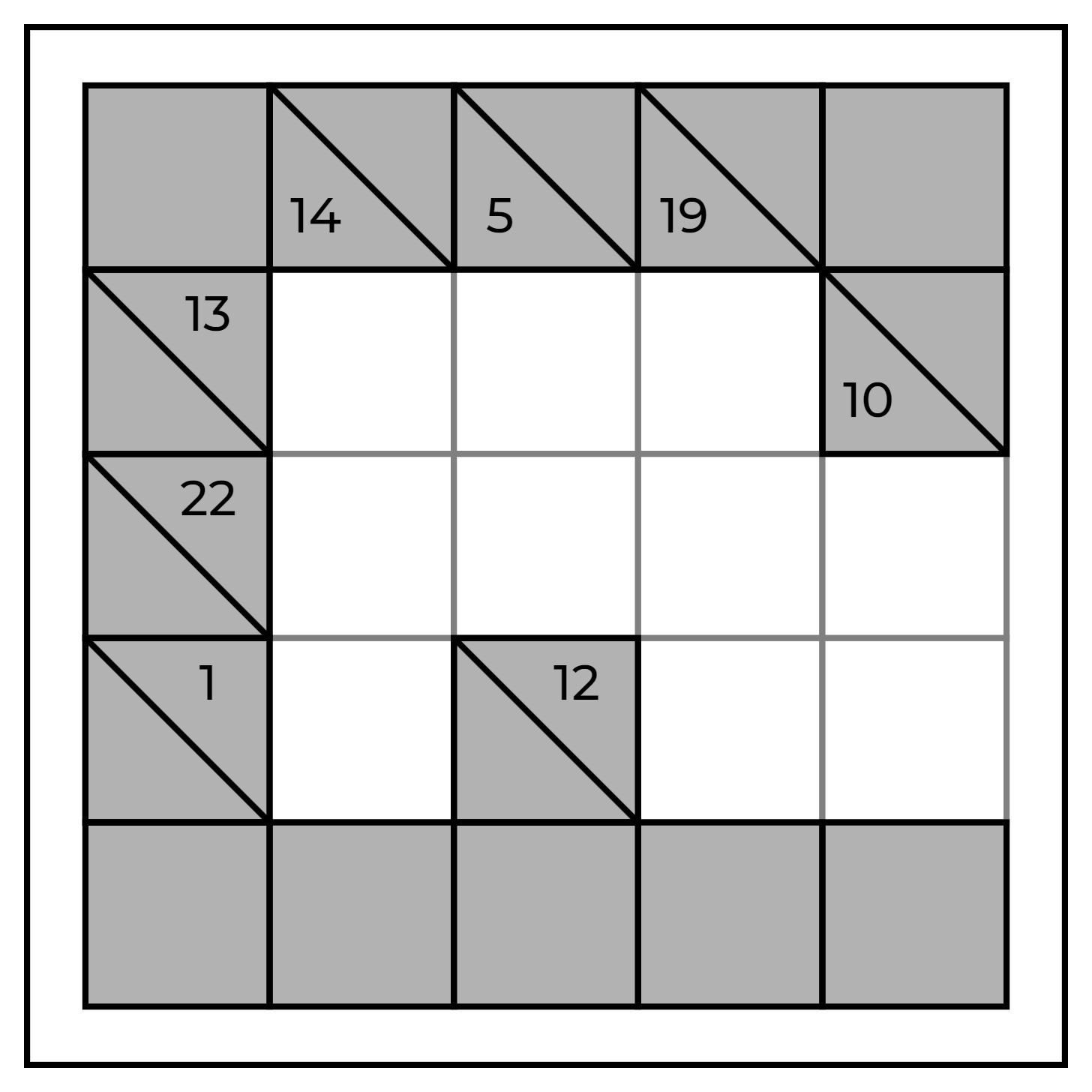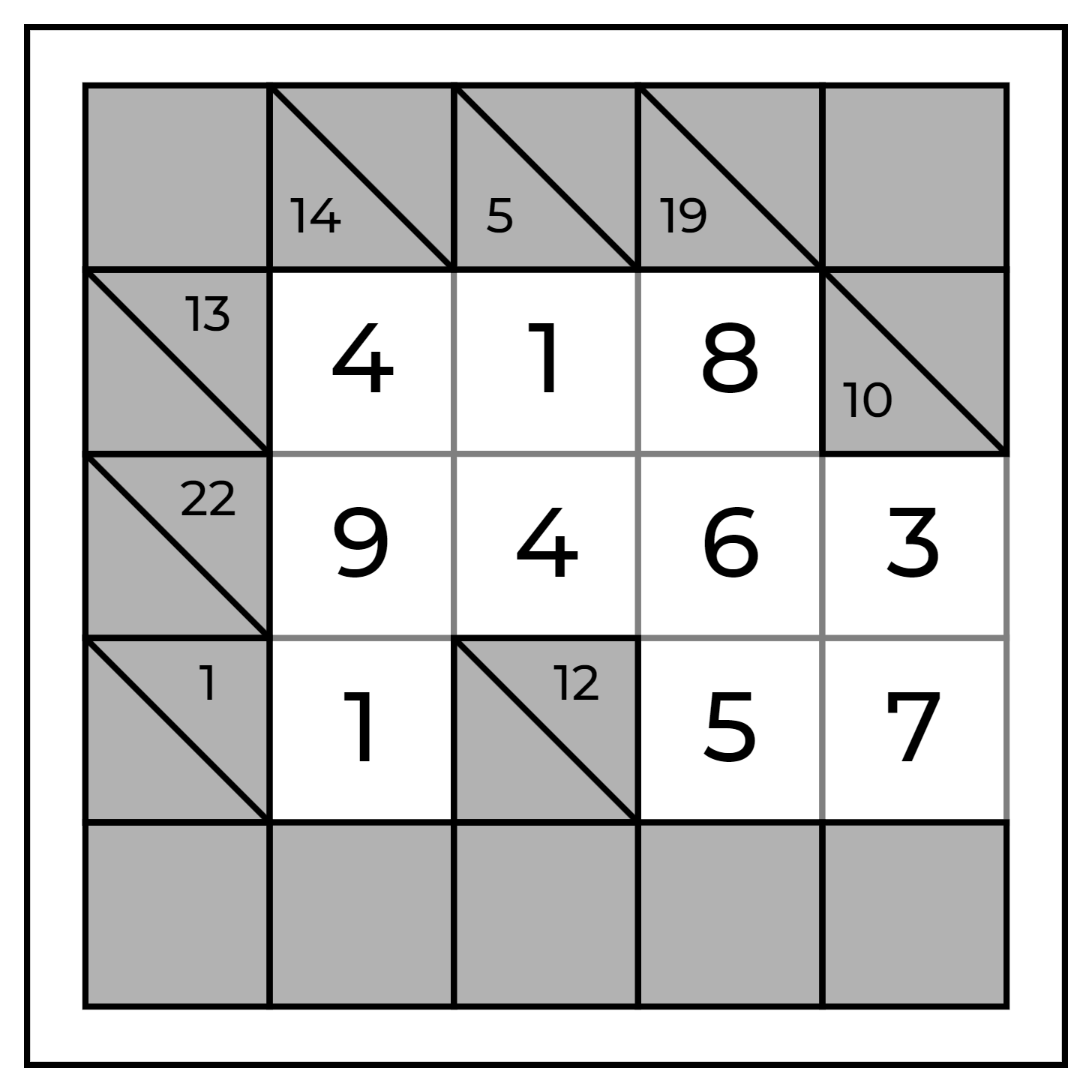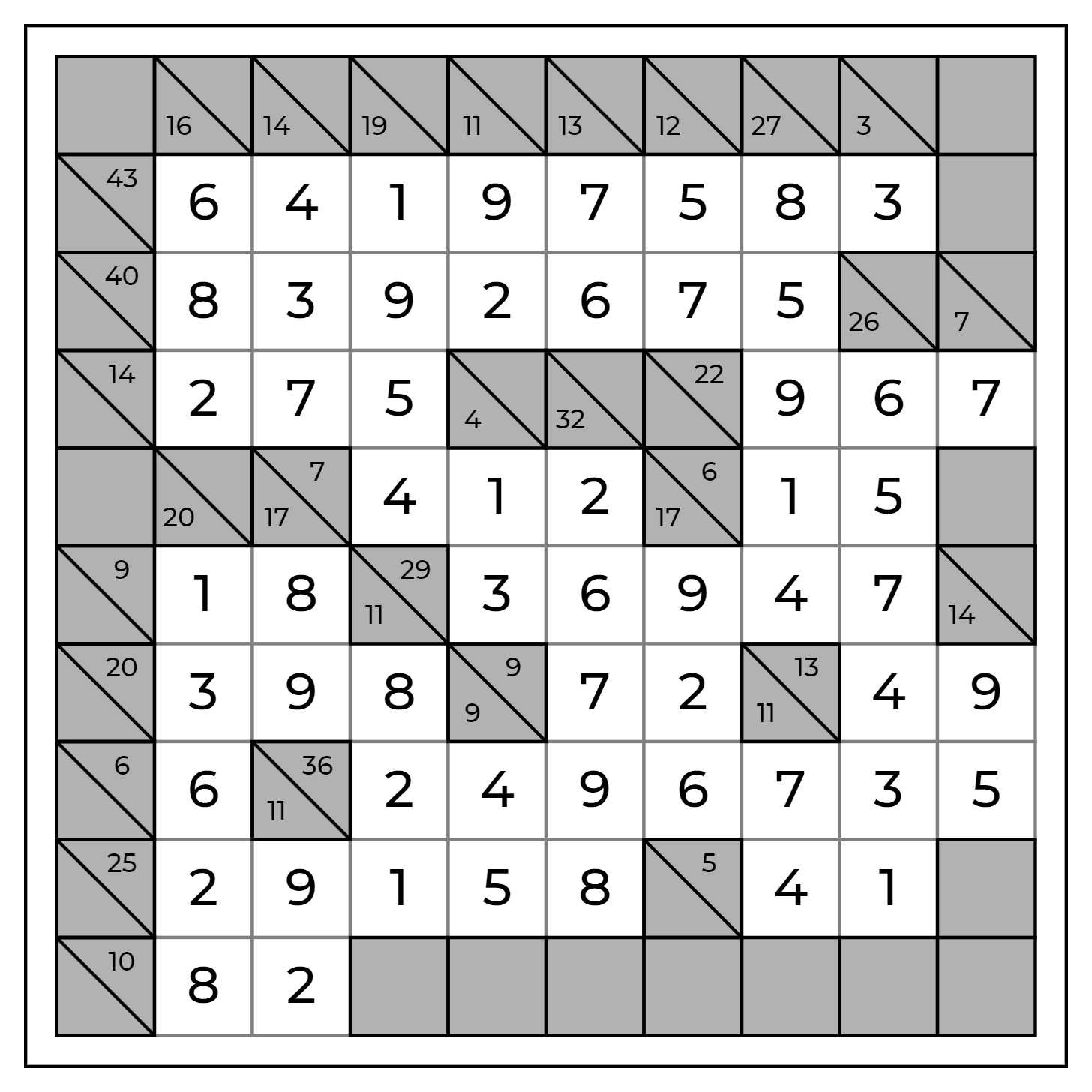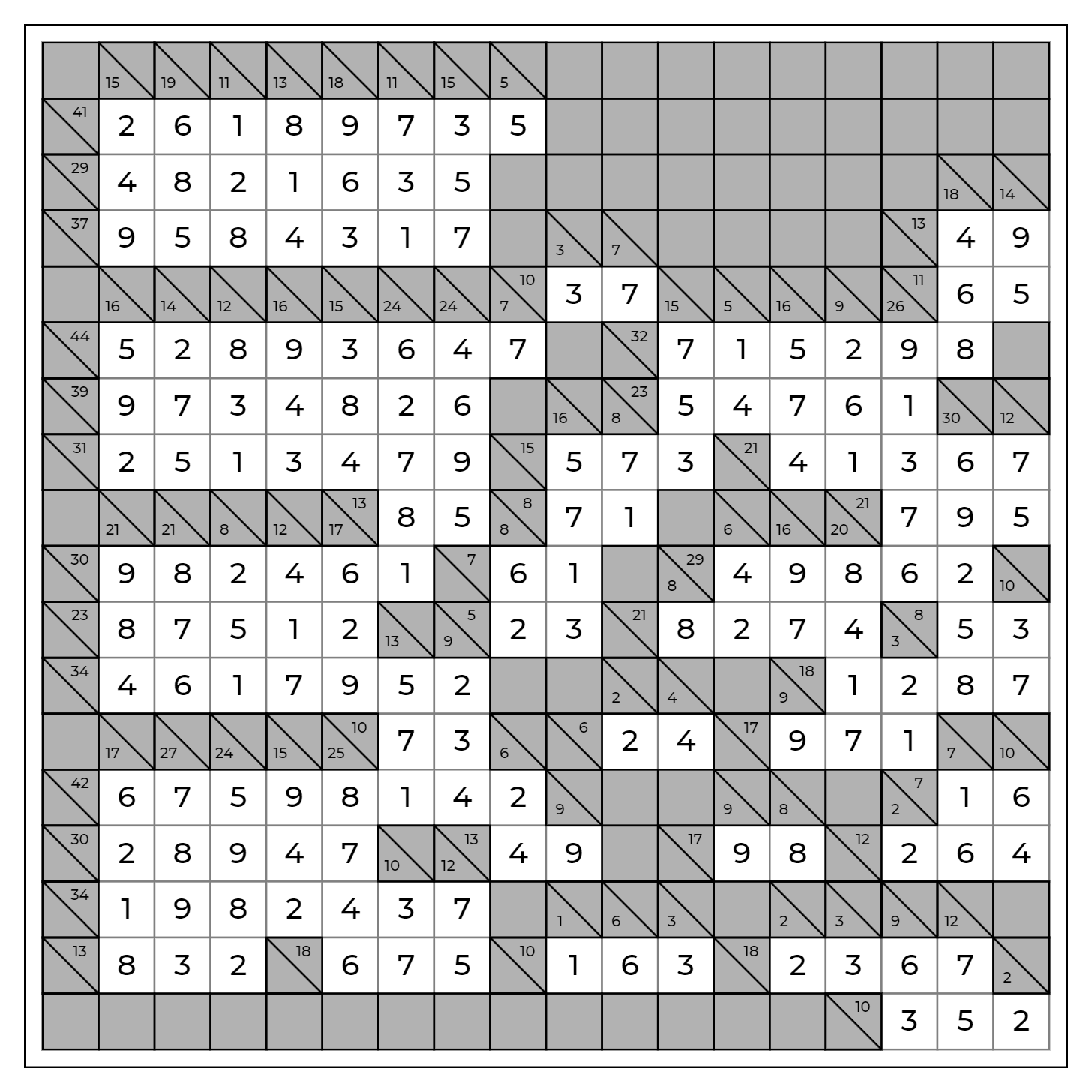Christmas Cookie Kakuro Puzzles
Embark on a festive journey through the enchanting realm of Kakuro, a number puzzle that has captured hearts and minds worldwide like the twinkling lights of a Christmas tree. From its humble beginnings to its current holiday-inspired popularity, this blog post will unwrap the essence of Kakuro puzzles, exploring its history, rules, and reasons behind its universal appeal.
Origins and Evolution of Kakuro
Kakuro’s roots can be traced back to crosswords and sudoku. Developed in Japan in the early 2000s, it quickly gained global recognition for its unique blend of logic and arithmetic, providing enthusiasts with a refreshing challenge.
How to Play Kakuro: A Numerical Symphony
Kakuro is a captivating number puzzle that combines logic and arithmetic to create a symphony of numerical harmony. Here’s a step-by-step guide on how to play this intriguing game:
1. The Game Board
- Kakuro is played on a grid, typically consisting of blank squares and shaded cells.
- The shaded cells contain a clue, representing the sum of the numbers in the adjacent, unshaded cells.
2. Number Placement
- Fill the blank squares with numbers from 1 to 9, ensuring that each number appears only once in each row and column.
3. Clues
- Use the provided clues to determine the combinations that add up to the specified sums in each row or column.
- The numbers in a combination cannot repeat within the same sum.
4. Logical Deduction
- Employ logical deduction to eliminate possibilities and narrow down the potential numbers for each cell.
- Pay attention to intersecting rows and columns to refine your choices.
5. Start with the Big Sums
- Begin by focusing on the larger sums, as they have fewer possible combinations and can serve as anchors for other numbers in the grid.
6. Break Down the Sums
- Break down larger sums into smaller combinations to simplify the process of finding suitable numbers for each cell.
7. Avoid Repetition
- Ensure that numbers are not repeated in a row or column, adhering to the rules of the game.
8. Practice Patience
- Kakuro rewards patience and persistence. Feel free to make educated guesses and refine your approach through trial and error.
9. Complete the Grid
- Continue solving and filling in numbers until the entire grid is complete, adhering to the rules of each sum and maintaining numerical order.
10. Enjoy the Challenge
- Kakuro is not just a puzzle; it’s a mental workout that combines strategy and numerical skill. Embrace the challenge, enjoy the process, and celebrate the satisfaction of completing each puzzle.
Now that you know the basics, dive into the world of Kakuro and let the numerical symphony BEGIN.
Different Levels of Kakuro Puzzles
Kakuro, a captivating number puzzle, offers a spectrum of difficulty levels to cater to players of varying expertise. From beginners to seasoned enthusiasts, each level presents its own set of challenges, ensuring a nuanced and engaging experience.
Easy

Immerse yourself in a winter wonderland of Kakuro puzzles with a frosty twist. The solutions, like snow-covered treasures, await your discovery at the end of this blog post.
Easy Kakuro puzzles, Ideal for newcomers, introduce basic concepts and logical deductions.
Grids have more filled-in cells and straightforward clues, allowing players to grasp the fundamentals.
Intermediate

Try the sweetness of the season with our Gingerbread Kakuro puzzle. The solutions, like hidden treasures in a sugary village, await you at the end of this Christmassy Kakuro adventure.
Intermediate Kakuro presents a moderate challenge, requiring a deeper understanding of number combinations.
Clues become more intricate, demanding players to apply logical deduction skills with increased complexity.
Difficult

Now, test your skills and tackle this difficult Kakuro puzzle. The solution is ready and waiting for you at the end.
As players advance, difficult Kakuro puzzles pose substantial challenges, often featuring larger grid sizes.
Logical deduction becomes crucial, and solving may involve intricate strategies and thoughtful planning.
Kakuro’s versatility extends to variations like Mega Kakuro or Samurai Kakuro, which combine multiple grids, adding an extra layer of complexity and strategy.
Kakuro vs. Sudoku: A Comparison of Two Popular Number Puzzles
Grid Structure
Kakuro: Kakuro grids often feature irregularly shaped blocks, adding an extra layer of complexity as players work to fill in the cells with appropriate number combinations.
Sudoku: Sudoku grids maintain a consistent 9×9 structure, providing a uniform canvas for logical deduction and placement.
Clue Complexity
Kakuro: Clues in Kakuro are sums, indicating the total of numbers in a particular row or column, offering a nuanced challenge in deciphering possible combinations.
Sudoku: Sudoku clues are direct numbers placed in the grid, guiding players to deduce the correct placement based on these given digits.
Variety in Patterns
Kakuro: Kakuro puzzles showcase a variety of patterns and arrangements with different grid sizes and difficulty levels, offering a diverse range of challenges for players.
Sudoku: While Sudoku comes in various difficulty levels, its patterns are more standardized, relying on the strategic placement of numbers within the fixed 9×9 grid.
As the snowflakes gently fall, let’s navigate through the serene landscape of number puzzles, where Kakuro and Sudoku stand as the guardians of a winter wonderland. These two favorites share the chill in the air and the warmth of a cozy challenge. So, check it NOW.
Health Benefits of Playing Kakuro Puzzles
- Stimulates brain activity
- Enhances cognitive abilities
- Boosts problem-solving skills
- Improves concentration and focus
- Fosters logical thinking
- Encourages perseverance
- Provides a sense of accomplishment
Kakuro for All Ages: Puzzling Fun for Kids, Adults, and Seniors
Kakuro’s timeless appeal transcends generations. It’s an engaging tool for children to develop critical thinking, provides adults with a mental challenge, and offers seniors a stimulating activity. With varying difficulty levels, Kakuro ensures puzzling fun for everyone, making it a truly ageless pastime.
FAQs
What are Kakuro puzzles?
Kakuro is a number puzzle game that combines elements of crosswords and sudoku. Played on a grid, players fill in cells with numbers from 1 to 9, ensuring the sum of the numbers in each row or column matches the specified clue.
How are Kakuro puzzles different from Sudoku puzzles?
While both involve numbers in a grid, Kakuro focuses on numerical combinations to reach specific sums in rows and columns. Sudoku, in contrast, relies on the logical placement of numbers 1 to 9 in a 9×9 grid without the arithmetic aspect.
Are there different levels of difficulty in Kakuro puzzles?
Yes, Kakuro puzzles come in various levels of difficulty, ranging from easy to expert. The grid size, clue complexity, and the number of filled-in cells contribute to the puzzle’s difficulty level, providing a challenge for both beginners and seasoned players.
Conclusion
In this festive exploration of Kakuro, we’ve unwrapped the puzzle’s rich history, the art of its numerical symphony, and its charming duel with Sudoku in a winter wonderland. From the intricacies of grid structures to the diverse patterns and health benefits, Kakuro proves itself as a timeless pastime for all ages. As the snowflakes settle on these puzzles, Kakuro stands as not just a game but a mental journey, offering challenges, joys, and a harmonious blend of tradition and ever-evolving complexity.
If you want to create books to sell, or to print them off at home to enjoy then this tool has a variety of different puzzles you can create, including kakuro puzzles. Check it out here.
Kakuro Puzzles Solution



- Facebook0
- Twitter1
- Pinterest5
- LinkedIn0
- 6 shares





